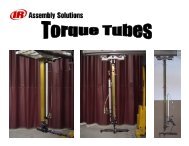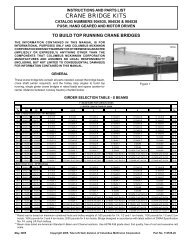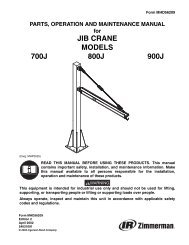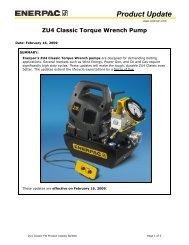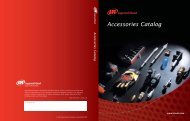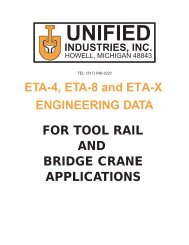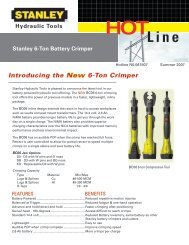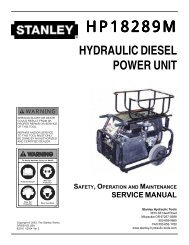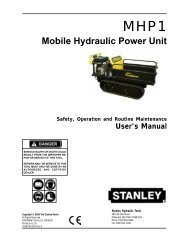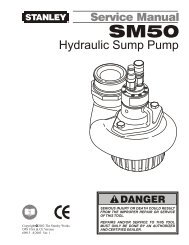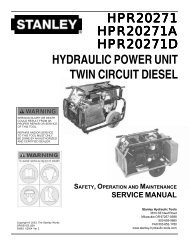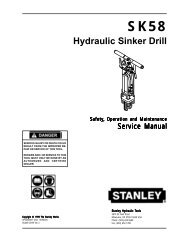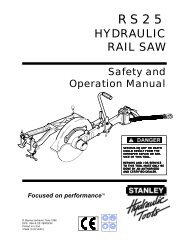Safety, and Operation User's Manual - Tool-Smith
Safety, and Operation User's Manual - Tool-Smith
Safety, and Operation User's Manual - Tool-Smith
You also want an ePaper? Increase the reach of your titles
YUMPU automatically turns print PDFs into web optimized ePapers that Google loves.
Remote ON/OFF Valve Model<br />
SERIOUS INJURY OR DEATH<br />
COULD RESULT FROM THE<br />
IMPROPER REPAIR OR<br />
SERVICE OF THIS TOOL.<br />
REPAIRS AND/OR SERVICE TO<br />
THIS TOOL MUST ONLY BE<br />
DONE BY AN AUTHORIZED AND<br />
CERTIFIED DEALER.<br />
Read<br />
The<br />
<strong>Manual</strong><br />
Wear<br />
Breathing<br />
Protection<br />
Wear<br />
Hearing<br />
Protection<br />
Wear<br />
Eye<br />
Protection<br />
c<br />
Copyright 2001 The Stanley Works<br />
OPS USA<br />
59010 01/03 Ver. 2<br />
PD45<br />
Post Driver<br />
Valve-In-H<strong>and</strong>le Model<br />
<strong>Safety</strong>, <strong>and</strong> <strong>Operation</strong><br />
User’s <strong>Manual</strong><br />
STANLEY<br />
Stanley Hydraulic <strong>Tool</strong>s<br />
3810 SE Naef Road<br />
Milwaukie, OR 97267-5698 USA<br />
Phone: (503) 659-5660<br />
Fax: (503) 652-1780
Table of Contents<br />
PD45<br />
Post Driver<br />
Under copyright law, this document may<br />
not be copied in whole or in part without<br />
the prior written consent of The Stanley<br />
Works. This exception does not permit<br />
copies to be made for others, whether or<br />
not sold. Under the law, copying includes<br />
translating into another language, format<br />
or medium. This copyright notice must<br />
appear on any permitted copies.<br />
1<br />
SERVICING THE<br />
PD45 Post Driver:<br />
This manual contains <strong>Safety</strong>,<br />
<strong>Operation</strong>, <strong>and</strong> Troubleshooting<br />
information. Stanley Hydraulic <strong>Tool</strong>s<br />
recommends that servicing of<br />
hydraulic tools, other than routine<br />
maintenance, must be performed<br />
by an authorized <strong>and</strong> certified<br />
dealer. Please read the DANGER<br />
warning on the cover <strong>and</strong> the<br />
SAFETY warning below.<br />
c<br />
Copyright 2001 The Stanley Works<br />
All rights reserved.<br />
Specifications<br />
<strong>Safety</strong> Symbols<br />
General <strong>Safety</strong> Instructions<br />
<strong>Tool</strong> Decals <strong>and</strong> Tags<br />
Hydraulic Hose Requirements<br />
HTMA Requirements<br />
Operating Instructions<br />
Troubleshooting<br />
Maintenance<br />
Parts Illustration<br />
Parts List<br />
Accessories<br />
Warranty<br />
2<br />
3<br />
4<br />
5<br />
6<br />
7<br />
8<br />
9-10<br />
11<br />
12 & 13<br />
14 & 15<br />
SAFETY FIRST<br />
It is the responsibility of the operator <strong>and</strong><br />
service technician to read rules <strong>and</strong><br />
instructions for safe <strong>and</strong> proper operation<br />
<strong>and</strong> maintenance.<br />
A cautious worker using common sense is<br />
the greatest safety device.<br />
16<br />
17
Weight (St<strong>and</strong>ard)_____________65 lbs / 29.5 kg<br />
Weight (Extended anvil)__________71 lbs / 32 kg.<br />
Pressure Range_____________2000 psi / 140 bar<br />
Flow Range______________7-9 gpm / 26-34 lmp<br />
Optimum Flow_________________8 gpm / 30 lpm<br />
Couplers_________________ HTMA Flush Face<br />
Per NFPA T3.20.15/ISO 16028<br />
Connect Size_________________3/8 female pipe<br />
Length________________________30 in. / 76 cm<br />
Width (Across H<strong>and</strong>les)_______10-1/8 in./25.7 cm<br />
System Type___________________open center<br />
Specifications<br />
Port Size_____________________SAE 8 O-Ring<br />
Hose Whips___________________________Yes<br />
Capacity______________________#2, #3 <strong>and</strong> #4 lb/ft.<br />
"U" Channel Sign Post<br />
_______________#3 <strong>and</strong> #4 Strong Back (Heavy Duty)<br />
"U" Channel Sign Post<br />
_____________________________#1 Delineator Post<br />
___________________2-1/2 in. / 63.5 mm Square Post<br />
_____________________2-5/8 in. / 67 mm Round Post<br />
30Lpm at 138bar<br />
BHTMA CATEGORY<br />
HTMA Class II _________7-9<br />
gpm @ 2000 psi<br />
NOTE<br />
Weights, dimensions <strong>and</strong> operating specifications listed are subject to change<br />
without notice. Where specifications are critical to your application, please<br />
consult the factory.<br />
2
<strong>Safety</strong> symbols <strong>and</strong> signal words, as shown below, are used to emphasize all operator, maintenance<br />
<strong>and</strong> repair actions which, if not strictly followed, could result in a life-threatening situation, bodily injury<br />
or damage to equipment.<br />
This is the safety alert symbol. It is used to alert you to potential personal<br />
injury hazards. Obey all safety messages that follow this symbol to avoid<br />
possible injury or death.<br />
This safety alert <strong>and</strong> signal word indicate an imminently hazardous<br />
situation which, if not avoided, will result in death or serious injury.<br />
This safety alert <strong>and</strong> signal word indicate a potentially hazardous<br />
situation which, if not avoided, could result in death or serious injury.<br />
This safety alert <strong>and</strong> signal word indicate a potentially hazardous situation<br />
which, if not avoided, may result in minor or moderate injury.<br />
This signal word indicates a potentially hazardous situation which, if not<br />
avoided, may result in property damage.<br />
This signal word indicates a situation which, if not avoided, will result in<br />
damage to the equipment.<br />
This signal word indicates a situation which, if not avoided, may result in<br />
damage to the equipment.<br />
Always observe safety symbols. They are included for your safety <strong>and</strong> for the protection of the tool.<br />
LOCAL SAFETY REGULATIONS<br />
Enter any local safety regulations here. Keep these instructions in an area accessible<br />
to the operator <strong>and</strong> maintenance personnel.<br />
SAFETY SYMBOLS<br />
SOME HYDRAULIC FLUIDS ARE FLAMMABLE, NEVER ALLOW THESE<br />
HYDRAULIC FLUIDS TO COME IN CONTACT WITH AN OPEN FLAME.<br />
IF A HOSE WERE TO BURST OR IF A TOOL LEAK OCCURS NEXT TO<br />
AN OPEN FLAME, THESE HYDRAULIC FLUIDS WILL IGNITE AND<br />
COULD RESULT IN SERIOUS INJURY OR DEATH.<br />
3
4<br />
General <strong>Safety</strong> Instructions<br />
� Operator must start in a work area without byst<strong>and</strong>ers. The operator must be familiar with all prohibited work<br />
areas such as excessive slopes <strong>and</strong> dangerous terrain conditions.<br />
�<br />
�<br />
�<br />
�<br />
�<br />
�<br />
�<br />
�<br />
�<br />
�<br />
�<br />
�<br />
�<br />
�<br />
�<br />
�<br />
�<br />
�<br />
<strong>Tool</strong> operators <strong>and</strong> maintenance personnel must always comply with the safety precautions<br />
given in this manual <strong>and</strong> on the stickers <strong>and</strong> tags attached to the tool <strong>and</strong> hose.<br />
These safety precautions are given for your safety. Review them carefully before operating<br />
the tool <strong>and</strong> before performing general maintenance or repairs.<br />
Supervising personnel should develop additional precautions relating to the specific work<br />
area <strong>and</strong> local safety regulations. If so, place the added precautions in the space provided<br />
on page 5.<br />
This tool will provide safe <strong>and</strong> dependable service if operated in accordance with the instructions<br />
given in this manual. Read <strong>and</strong> underst<strong>and</strong> this manual <strong>and</strong> any stickers <strong>and</strong> tags attached to the<br />
tool <strong>and</strong> hoses before operation. Failure to do so could result in personal injury or equipment<br />
damage.<br />
Establish a training program for all operators to ensure safe operations.<br />
Do not operate the tool unless thoroughly trained or under the supervision of an instructor.<br />
Always wear safety equipment such as goggles, head protection, <strong>and</strong> safety shoes at all times when operating<br />
the tool.<br />
Do not inspect or clean the tool while the hydraulic power source is connected. Accidental engagement of the<br />
tool can cause serious injury.<br />
Do not operate this tool without first reading the Operating Instructions.<br />
Do not install or remove this tool while the hydraulic power source is connected. Accidental engagement of<br />
the tool can cause serious injury.<br />
Never operate the tool if you cannot be sure that underground utilities are not present. Underground electrical<br />
utilities present an electrocution hazard. Underground gas utilities present an explosion hazard. Other<br />
underground utilities may present other hazards.<br />
Do not wear loose fitting clothing when operating the tool. Loose fitting clothing can get entangled with the<br />
tool <strong>and</strong> cause serious injury.<br />
Supply hoses must have a minimum working pressure rating of 2500 psi/175 bar.<br />
Be sure all hose connections are tight.<br />
The hydraulic circuit control valve must be in the “OFF” position when coupling or uncoupling the tool. Wipe<br />
all couplers clean before connecting. Failure to do so may result in damage to the quick couplers <strong>and</strong> cause<br />
overheating. Use only lint-free cloths.<br />
Do not operate the tool at oil temperatures above 140 ° F/60 ° C. <strong>Operation</strong> at higher oil temperatures can<br />
cause operator discomfort <strong>and</strong> may cause damage to the tool.<br />
Do not operate a damaged, improperly adjusted, or incompletely assembled tool.<br />
To avoid personal injury or equipment damage, all tool repair, maintenance <strong>and</strong> service must only be<br />
performed by authorized <strong>and</strong> properly trained personnel.<br />
Do not exceed the rated limits of the tool or use the tool for applications beyond its design capacity.<br />
Always keep critical tool markings, such as labels <strong>and</strong> warning stickers legible.<br />
Always replace parts with replacement parts recommended by Stanley Hydraulic <strong>Tool</strong>s.<br />
Check fastener tightness often <strong>and</strong> before each use daily.
The SAFETY TAG, P/N 15875, shown at right, smaller<br />
than actual size, is attached to the tool when shipped<br />
from the factory. Read <strong>and</strong> underst<strong>and</strong> the safety<br />
instructions listed on this tag before removal. We<br />
suggest you retain this tag <strong>and</strong> attach it to the tool<br />
when not in use.<br />
<strong>Tool</strong> Decals & Tags<br />
A Name Tag Sticker is attached to the tool. Never exceed the flow <strong>and</strong> pressure levels specified on<br />
this sticker.The information listed on the name tag sticker must be legible at all times. Replace this<br />
sticker if it becomes worn or damaged. A replacement is available from your local Stanley<br />
distributor.<br />
DANGER DANGER<br />
1. FAILURE TO USE HYDRAULIC HOSE LABELED AND<br />
CERTI-FIED AS NON-CONDUCTIVE WHEN USING<br />
HYDRAULIC TOOLS ON OR NEAR ELECTRICAL LINES<br />
MAY RESULT IN DEATH OR SERIOUS INJURY.<br />
BEFORE USING HOSE LABELED AND CERTIFIED AS<br />
NON- CONDUCTIVE ON OR NEAR ELECTRIC LINES.<br />
BE SURE THE HOSE IS MAINTAINED AS NON- CONDUC TIVE . THE<br />
HOSE SHOULD BE REGULARLY TESTED FOR ELECTRIC CURRENT<br />
LEAKAGE IN ACCORDANCE WITH YOUR SAFETY DEPARTMENT<br />
INSTRUCTIONS.<br />
2. A HYDRAULIC LEAK OR BURST MAY CAUSE OIL<br />
INJECTION INTO THE BODY OR CAUSE OTHER SEVERE PERSONAL<br />
INJURY.<br />
A.DO NOT EXCEED SPECIFIED FLOW AND<br />
PRESSURE FOR THIS TOOL. EXCESS FLOW OR<br />
PRESSURE MAY CAUSE A LEAK OR BURST.<br />
B. DO NOT EXCEED RATED WORKING PRESSURE<br />
OF HYDRAULIC HOSE USED WITH THIS TOOL.<br />
EXCESS PRESSURE MAY CAUSE A LEAK OR<br />
BURST.<br />
C. CHECK TOOL, HOSE, COUPLERS &<br />
C O N N E C T O R S D A I L Y F O R<br />
LEAKS. DO NOT FEEL FOR LEAKS WITH<br />
YOUR HANDS. CONTACT WITH A LEAK MAY<br />
RESULT IN SEVERE PERSONAL INJURY.<br />
D. DO NOT LIFT OR CARRY TOOL BY THE HOSES. DO NOT ABUSE<br />
HOSE. DO NOT USE KINKED, TORN OR DAMAGED HOSES.<br />
3. MAKE SURE HYDRAULIC HOSES ARE PROPERLY<br />
CONN-ECTED TO THE TOOL BEFORE PRESSURIZING<br />
SYSTEM. SYSTEM PRESSURE HOSE MUST ALWAYS<br />
BE CONNECTED TO TOOL “IN” PORT. SYSTEM<br />
RETURN HOSE MUST ALWAYS BE CONNECTED AT<br />
TOOL “OUT” PORT. REVERSING CONNECTIONS MAY<br />
CAUSE REVERSE TOOL OPERATION WHICH CAN<br />
CAUSE SEVERE PERSONAL INJURY.<br />
4. DO NOT CONNECT CLOSED-CENTER TOOLS TO<br />
OPEN-CENTER HYDRAULIC SYSTEMS. THIS MAY<br />
CAUSE EXTREME SYSTEM HEAT AND/OR SEVERE<br />
PERSONAL INJURY.<br />
DO NOT CONNECT OPEN-CENTER TOOLS TO CLO SE D- CE NT ER<br />
HYDRAULIC SYSTEMS. THIS MAY RESULT IN LOSS OF OTHER<br />
HYDRAULIC FUNCTIONS POWERED BY THE SAME SYSTEM AND/OR<br />
SEVERE PERSONAL INJURY.<br />
5. BYSTANDERS MAY BE INJURED IN YOUR WORK<br />
AREA. KEEP BYSTANDERS CLEAR OF YOUR WORK<br />
AREA.<br />
6. WEAR HEARING, EYE, FOOT, HAND AND HEAD PROTECTION.<br />
7. TO AVOID PERSONAL INJURY OR EQUIPMENT DAMAGE, ALL TOOL<br />
REPAIR, MAINTENANCE AND SERVICE MUST BE<br />
PERFORMED BY AUTHORIZED AN D PR OP ER LY<br />
TRAINED PERSONNEL.<br />
IMPORTANT IMPORTANT<br />
READ OPERATION MANUAL AND<br />
SAFETY INSTRUCTIONS FOR THIS<br />
TOOL BEFORE USING IT.<br />
USE ONLY PARTS AND REPAIR<br />
PROCEDURES APPROVED BY<br />
STANLEY AND DESCRIBED IN THE<br />
OPERATION MANUAL.<br />
15197<br />
Name Tag<br />
READ OPERATION MANUAL AND<br />
SAFETY INSTRUCTIONS FOR THIS<br />
TOOL BEFORE USING IT.<br />
USE ONLY PARTS AND REPAIR<br />
PROCEDURES APPROVED BY<br />
STANLEY AND DESCRIBED IN THE<br />
OPERATION MANUAL.<br />
TAG TO BE REMOVED ONLY BY TOOL<br />
OPERATOR.<br />
TAG TO BE REMOVED ONLY BY TOOL<br />
OPERATOR.<br />
(517) SEE OTHER SIDE 15875 (517)<br />
SEE OTHER SIDE<br />
15875<br />
5
Hydraulic Hose Requirements<br />
HOSE TYPES<br />
Hydraulic hose types authorized for use with Stanley Hydraulic <strong>Tool</strong>s are as follows:<br />
Certified non-conductive<br />
Wire-braided (conductive)<br />
Fabric-braided (not certified or labeled non-conductive)<br />
Hose listed above is the only hose authorized for use near electrical conductors.<br />
Hoses <strong>and</strong> listed above are conductive <strong>and</strong> must never be near electrical conductors.<br />
HOSE SAFETY TAGS<br />
To help ensure your safety, the following DANGER tags are attached to all hoses purchased from Stanley<br />
Hydraulic <strong>Tool</strong>s. DO NOT REMOVE THESE TAGS.<br />
If the information in a tag is illegible because of wear or damage, replace the tag immediately. A new tag<br />
may be obtained at no charge from your Stanley Distributor.<br />
HOSE PRESSURE RATING<br />
The rated working pressure of the hydraulic hose must be equal to or higher than the relief valve setting on<br />
the hydraulic system.<br />
6<br />
DO NOT REMOVE THIS TAG<br />
DO NOT REMOVE THIS TAG<br />
1.<br />
2.<br />
3.<br />
1.<br />
2.<br />
This Tag attached to “Certified Non-Conductive” hose.<br />
(shown smaller than actual size) p/n 27987<br />
DANGER<br />
FAILURE TO USE HYDRAULIC HOSE LABELED AND CERTIFIED AS NON-CONDUCTIVE WHEN USING<br />
HYDRAULIC TOOLS ON OR NEAR ELECTRIC LINES MAY RESULT IN DEATH OR SERIOUS INJURY.<br />
FOR PROPER AND SAFE OPERATION, MAKE SURE THAT YOU HAVE BEEN PROPERLY TRAINED IN<br />
CORRECT PROCEDURES REQUIRED FOR WORK ON OR AROUND ELECTRIC LINES.<br />
BEFORE USING HYDRAULIC HOSE LABELED AND CERTIFIED AS NON-CONDUCTIVE ON OR NEAR<br />
ELECTRIC LINES, WIPE THE ENTIRE LENGTH OF THE HOSE AND FITTINGS WITH A CLEAN,<br />
DRY, ABSORBENT CLOTH TO REMOVE DIRT AND MOISTURE AND TEST HOSE FOR MAXIMUM<br />
ALLOWABLE CURRENT LEAKAGE IN ACCORDANCE WITH SAFETY DEPARTMENT INSTRUCTIONS.<br />
DO NOT EXCEED HOSE WORKING PRESSURE OR ABUSE HOSE. IMPROPER USE OR HANDLING OF<br />
HOSE COULD RESULT IN BURST OR OTHER HOSE FAILURE. KEEP HOSE AS FAR AWAY AS<br />
POSSIBLE FROM BODY AND DO NOT PERMIT DIRECT CONTACT DURING USE. CONTACT AT THE<br />
BURST CAN CAUSE BODILY INJECTION AND SEVERE PERSONAL INJURY.<br />
SEE OTHER SIDE<br />
4. HANDLE AND ROUTE HOSE CAREFULLY TO AVOID KINKING, ABRASION, CUTTING OR CONTACT<br />
WITH HIGH TEMPERATURE SURFACES. DO NOT USE IF KINKED. DO NOT USE HOSE TO PULL OR<br />
LIFT TOOLS, POWER UNITS, ETC.<br />
SEE OTHER SIDE<br />
DANGER<br />
4. HANDLE AND ROUTE HOSE CAREFULLY TO AVOID KINKING, ABRASION, CUTTING OR CONTACT<br />
WITH HIGH TEMPERATURE SURFACES. DO NOT USE IF KINKED. DO NOT USE HOSE TO PULL OR<br />
LIFT TOOLS, POWER UNITS, ETC.<br />
5.<br />
CHECK ENTIRE HOSE FOR CUTS, CRACKS, LEAKS, ABRASIONS, BULGES OR DAMAGE TO<br />
COUPLINGS. IF ANY OF THESE CONDITIONS EXIST, REPLACE THE HOSE IMMEDIATELY.<br />
NEVER USE TAPE OR ANY DEVICE TO ATTEMPT TO MEND THE HOSE.<br />
6. AFTER EACH USE, STORE IN A CLEAN, DRY AREA.<br />
5.<br />
SEE OTHER SIDE<br />
Side 1 Side 2<br />
This Tag attached to “Conductive” hose.<br />
(shown smaller than actual size) p/n 29144<br />
DANGER<br />
DO NOT USE THIS HYDRAULIC HOSE ON OR NEAR ELECTRIC LINES. THIS HOSE IS NOT<br />
LABELED OR CERTIFIED AS NON-CONDUCTIVE. USING THIS HOSE ON OR NEAR ELECTRIC LINES<br />
MAY RESULT IN DEATH OR SERIOUS INJURY.<br />
FOR PROPER AND SAFE OPERATION, MAKE SURE THAT YOU HAVE BEEN PROPERLY TRAINED IN<br />
CORRECT PROCEDURES REQUIRED FOR WORK ON OR AROUND ELECTRIC LINES.<br />
3. DO NOT EXCEED HOSE WORKING PRESSURE OR ABUSE HOSE. IMPROPER USE OR HANDLING OF<br />
HOSE COULD RESULT IN BURST OR OTHER HOSE FAILURE. KEEP HOSE AS FAR AWAY AS<br />
POSSIBLE FROM BODY AND DO NOT PERMIT CONTACT DURING USE. CONTACT AT THE<br />
BURST CAN CAUSE BODILY INJECTION AND SEVERE PERSONAL INJURY.<br />
DANGER<br />
CHECK ENTIRE HOSE FOR CUTS, CRACKS, LEAKS, ABRASIONS, BULGES OR DAMAGE TO<br />
COUPLINGS. IF ANY OF THESE CONDITIONS EXIST, REPLACE THE HOSE IMMEDIATELY.<br />
NEVER USE TAPE OR ANY DEVICE TO ATTEMPT TO MEND THE HOSE.<br />
6. AFTER EACH USE, STORE IN A CLEAN, DRY AREA.<br />
SEE OTHER SIDE<br />
Side 1 Side 2<br />
DO NOT REMOVE THIS TAG<br />
DO NOT REMOVE THIS TAG
Hydraulic System<br />
Requirements<br />
Flow rate<br />
<strong>Tool</strong> Operating Pressure<br />
(at the power supply outlet)<br />
System relief valve setting<br />
(at the power supply outlet)<br />
Maximum back pressure<br />
(at tool end of the return hose)<br />
Measured at a max. fluid viscosity of:<br />
(at min. operating temperature)<br />
Temperature<br />
Sufficient heat rejection capacity<br />
to limit max. fluid temperature to:<br />
(at max. expected ambient temperature)<br />
Min. cooling capacity<br />
at a temperature difference of<br />
between ambient <strong>and</strong> fluid temps<br />
<strong>Tool</strong><br />
Category:<br />
HTMA Requirements<br />
Type I Type II Type III<br />
NOTE: Do not operate the tool at oil temperatures above 140 ° F (60° C). <strong>Operation</strong> at higher temperatures can cause operator<br />
discomfort at the tool.<br />
Filter<br />
Min. full-flow filtration<br />
sized for flow of at least:<br />
(For cold temp. startup <strong>and</strong> max. dirt-holding capacity)<br />
Hydraulic fluid<br />
Petroleum based<br />
(premium grade, anti-wear, non-conductive)<br />
Viscosity<br />
(at min. <strong>and</strong> max. operating temps)<br />
NOTE: When choosing hydraulic fluid, the expected oil temperature extremes that will be experienced in service determine the<br />
most suitable temperature viscosity characteristics. Hydraulic fluids with a viscosity index over 140 will meet the requirements over<br />
a wide range of operating temperatures.<br />
*SSU = Saybolt Seconds Universal<br />
These are general hydraulic system<br />
requirements. See tool specifications<br />
page for tool specific requirements.<br />
4-6 GPM<br />
lpm)<br />
2000 psi<br />
2100-2250<br />
(145-155 bar)<br />
250 psi<br />
(17 bar)<br />
400 SSU<br />
(82 centistokes)<br />
140°<br />
F<br />
3 hp<br />
40°<br />
F<br />
20Lpm at 138bar<br />
BHTMA CATEGORY<br />
7-9 GPM<br />
(15-23<br />
Lpm)<br />
(138 bar)<br />
(60° C)<br />
(2.24 kW)<br />
(22° C)<br />
25 microns<br />
30 GPM<br />
(114 lpm)<br />
100-400 SSU*<br />
(20-82 centistokes)<br />
2000 psi<br />
2100-2250<br />
(145-155 bar)<br />
250 psi<br />
(17 bar)<br />
400 SSU<br />
NOTE: These are general hydraulic system requirements. See tool Specification page for tool specific<br />
requirements.<br />
(26-34<br />
(82 centistokes)<br />
140°<br />
F<br />
5 hp<br />
40°<br />
F<br />
30Lpm at 138bar<br />
BHTMA CATEGORY<br />
(138 bar)<br />
(60° C)<br />
(3.73 kW)<br />
(22° C)<br />
25 microns<br />
30 GPM<br />
(114 lpm)<br />
100-400 SSU*<br />
(20-82 centistokes)<br />
11-13 GPM<br />
lpm)<br />
2000 psi<br />
2100-2250<br />
(145-155 bar)<br />
250 psi<br />
(17 bar)<br />
400 SSU<br />
(82 centistokes)<br />
140°<br />
F<br />
7 hp<br />
40°<br />
F<br />
(42-49<br />
(138 bar)<br />
(60° C)<br />
(5.22 kW)<br />
(22° C)<br />
25 microns<br />
30 GPM<br />
(114 lpm)<br />
100-400 SSU*<br />
(20-82 centistokes)<br />
9-10.5 GPM<br />
lpm)<br />
2000 psi<br />
2200-2300<br />
(152-159 bar)<br />
250 psi<br />
(17 bar)<br />
140°<br />
F<br />
6 hp<br />
40°<br />
F<br />
Type RR<br />
400 SSU<br />
(82 centistokes)<br />
(60° C)<br />
(4.5 kW)<br />
(22° C)<br />
25 microns<br />
30 GPM<br />
(114 lpm)<br />
100-400 SSU*<br />
(34-40<br />
(138 bar)<br />
(20-82 centistokes)<br />
7
Operating Instructions<br />
Pre-<strong>Operation</strong> Procedures<br />
Check the power source<br />
1. Using a calibrated flowmeter <strong>and</strong> pressure<br />
guage, check that the hydraulic power source<br />
develops a flow of 7-9 gpm/26-34 lpm at 2000<br />
psi/140 bar.<br />
2. Make certain the hydraulic power source is<br />
equipped with a relief valve set to open at<br />
2100-2250 psi/140 bar.<br />
Installing Adapters<br />
1. The post hammer is designed to drive No. 1<br />
thought No. 4 sign post, 2-1/2 inch square <strong>and</strong><br />
up to 2-5/8 inch diameter round post without<br />
requiring adapters. If you are driving one of<br />
these types of post, orient the post into the<br />
tightest fit in the post driver foot.<br />
2. If you are driving smaller square or round<br />
post, insert the adapter to the post driver foot<br />
using two ½-hex head capscrews.<br />
Connecting Hoses<br />
1. Wipe all hose couplers with a clean, lint-free<br />
cloth before making connections.<br />
2. Connect the hoses from the hydraulic power<br />
source to the tool fittings or quick disconnects.<br />
It is a good practice to connect return hoses<br />
first <strong>and</strong> disconnect them last to minimize or<br />
avoid trapped pressure within the tool.<br />
3. If hose couplers are used, observe the arrow<br />
on the coupler to ensure that the flow is in the<br />
proper direction. The female coupler on the<br />
tool hose is the inlet (pressure) coupler.<br />
4. Move the hydraulic power source on/off<br />
control valve to the ON position to operate<br />
the tool.<br />
8<br />
Note: If uncoupled hoses are left in the<br />
sun. pressure increase inside the hoses<br />
may make them difficult to connect. When<br />
possible, connect the free ends of the<br />
operating hoses together.<br />
<strong>Tool</strong> <strong>Operation</strong><br />
1. Observe all safety precautions.<br />
2. Install the appropriate adapter as required.<br />
3. Place the post driver foot firmly on the surface<br />
to be driven.<br />
4. Press the lever assembly on h<strong>and</strong>le to start the<br />
post driver.<br />
Note: On Remote ON/OFF Valve Models<br />
Place the post driver on/off control valve in<br />
The “ON” position to start the post driver.<br />
Note: Adequate down pressure is very<br />
important.<br />
5. When the post is fully set in the ground,<br />
release the lever assembly on h<strong>and</strong>le.<br />
Cold Weather <strong>Operation</strong><br />
If the post hammer is to be used during cold<br />
weather, preheat the hydraulic fluid at low engine<br />
speed. When using the normally recommended<br />
fluid, fluid temperature should be at or above<br />
50°F/10°C (400ssu/82 centistrokes) before use.<br />
Damage to the hydraulic system or post driver can<br />
result from use with fluid that is too viscous or<br />
thick.
Troubleshooting<br />
This section describes how to find <strong>and</strong> resolve problems users may experience. If a situation occurs that is<br />
not covered, call your Stanley Customer Service representative for assistance.<br />
If symptoms of poor performance develop, the following chart can be used as a guide to correct the problem.<br />
When diagnosing faults in operation of the tool, always check that the hydraulic power source is supplying<br />
the correct hydraulic flow <strong>and</strong> pressure to the tool as listed in the table. Use a flowmeter known to be<br />
accurate. Check the flow with the hydraulic oil temperature at least 80° F/27° C.<br />
<strong>Tool</strong> does not run. Power unit not functioning. *Check power source for proper<br />
flow <strong>and</strong> pressure (7-9 gpm / 26-34<br />
lpm, 2000 psi / 140 bar).<br />
<strong>Tool</strong> does not hit<br />
effectively.<br />
Couplers or Hoses blocked.<br />
Mechanical failure of piston or<br />
automatic valve.<br />
Power unit not functioning.<br />
WARNING<br />
Inspecting the tool or installing parts with the hydraulic hoses connected can result in severe personal injury or equipment<br />
damage.<br />
To prevent accidental startup, disconnect the hydraulic power before beginning any inspection or installation task.<br />
Symptom Possible Cause Solution<br />
Pressure <strong>and</strong> return line hoses<br />
reversed at ports.<br />
Couplers or hoses blocked.<br />
Low accumulator charge (pressure<br />
hose will pulse more than normal).<br />
* Refer to Page 7, Hydraulic Power Source Check<br />
Remove restriction.<br />
Be sure hoses are connected to<br />
their proper ports.<br />
Disassemble post driver <strong>and</strong><br />
inspect for damaged parts.<br />
*Check power unit for proper flow<br />
<strong>and</strong> pressure (7-9 gpm / 26-34 lpm,<br />
2000 psi / 140 bar).<br />
Remove restriction.<br />
Recharge accumulator. Replace<br />
diaphragm if charge loss continues.<br />
Fluid too hot (above 140°F / 60°C) Provide cooler to maintain proper<br />
oil temperature (130°F / 55°C<br />
maximum).<br />
The anvil is not sliding freely in the<br />
post driver foot.<br />
Remove, clean, lubricate <strong>and</strong><br />
replace anvil as required.<br />
continued<br />
9
Troubleshooting<br />
Symptom Possible Cause Solution<br />
<strong>Tool</strong> operates<br />
slow.<br />
10<br />
Low gpm supply from power unit *Check power source for proper<br />
flow (7-9 gpm / 26-64 lpm).<br />
High backpressure. Check hydraulic system for<br />
excessive backpressure (over 250<br />
psi / 17 bar).<br />
Couplers or hoses blocked. Remove restriction.<br />
Orifice blocked. Remove restriction.<br />
Fluid too hot (above 140°F / 60°C)<br />
or too cold (below 60°F / 16°C).<br />
Check power source for proper<br />
fluid temperature. Bypass cooler<br />
to warm fluid up or provide cooler<br />
to maintain proper temperature.<br />
Relief valve set too low. Adjust relief valve to 2100-2250<br />
psi / 145-155 bar.<br />
The anvil is not sliding freely in<br />
the post driver foot.<br />
Remove, clean, lubricate <strong>and</strong><br />
replace as required.<br />
<strong>Tool</strong> gets hot. Hot fluid going through tool. Check power unit. Be sure flow<br />
rate is not too high causing part of<br />
the fluid to go through the relief<br />
valve. Provide cooler to maintain<br />
proper fluid temperature (140°F /<br />
60°C max).<br />
Oil Leakage on<br />
post.<br />
Lower piston seal failure.<br />
* Refer to Page 7, Hydraulic Power Source Check.<br />
Check relief valve setting.<br />
Eliminate flow control devices.<br />
Replace seal.
Charging the Accumulator<br />
Accumulator Testing Procedure<br />
To check or charge the accumulator the following<br />
equipment is required:<br />
� Accumulator tester (Part Number 02835).<br />
� Charging kit assembly (Part Number 31254)<br />
(includes a regulator, hose <strong>and</strong> fittings).<br />
� NITROGEN bottle with an 800 psi/56 bar<br />
minimum charge.<br />
A. Remove the charging valve plug from the post<br />
driver.<br />
B. Holding the chuck end of Stanley tester (Part<br />
Number 02835), turn the gauge fully counterclockwise<br />
to ensure the stem inside the chuck is<br />
completely retracted.<br />
C. Thread the tester onto the charging valve of the<br />
tool accumulator, (Do not advance the guage-end<br />
into the chuck end. Turn as a unit.) Seat the chuck<br />
on the accumulator charging valve <strong>and</strong> h<strong>and</strong><br />
tighten only.<br />
D. Advance the valve stem by turning the guage-end<br />
clockwise until pressure is read on the guage<br />
(charging pressure should be 500-700 psi/<br />
34-38 bar).<br />
E. If pressure is OK unscrew the gauge-end from the<br />
chuck to retract the stem, then unscrew the entire<br />
tester assembly from the tool accumulator<br />
charging valve.<br />
Tester<br />
Charging<br />
Valve<br />
Guage<br />
Chuck<br />
Maintenance<br />
If pressure is low, charge the accumulator as<br />
described in the following section.<br />
F. Install the charging valve cap (or plug).<br />
Accumulator Charging Procedure<br />
A. Perform steps A through D of the accumulator<br />
testing procedure above.<br />
B. Connect the chuck of the charging assembly to<br />
the charging valve on the accumulator tester or, if<br />
preferred, remove the tester from the tool charging<br />
valve <strong>and</strong> connect the charging assembly chuck<br />
directly to the tool charging valve.<br />
C. Adjust the regulator to the charging pressure of<br />
600 psi/42 bar.<br />
Note: It may be necessary to set the<br />
regulator at 650 to 700 psi/45-48 bar to<br />
overcome any pressure drop through the<br />
charging system.<br />
D. Open the valve on the charging assembly hose.<br />
E. When the accumulator is fully charged close<br />
the valve on the charging assembly hose <strong>and</strong><br />
remove the charging assembly chuck from the<br />
accumulator tester of tool charging valve.<br />
F. If the accumulator tester has been used, be sure<br />
to turn the gauge-end fully counterclockwise<br />
before removing the tester from the charging<br />
valve of the tool.<br />
G. Replace the o-ring plug.<br />
Accumulator Tester (P/N 02835) Location Of Charging Valve<br />
11
PD45 Parts Illustration<br />
12<br />
8<br />
7<br />
6<br />
53<br />
16<br />
10<br />
55<br />
4<br />
4<br />
3<br />
11<br />
44<br />
17 18<br />
39<br />
56<br />
41<br />
19 20<br />
23<br />
15<br />
16<br />
14<br />
13<br />
21<br />
22<br />
25<br />
58<br />
15<br />
10<br />
31<br />
26<br />
57<br />
30<br />
7<br />
9<br />
5<br />
1<br />
47<br />
46<br />
2<br />
29<br />
28<br />
27<br />
45<br />
42<br />
45<br />
52<br />
54<br />
50<br />
51<br />
49<br />
48<br />
39<br />
40<br />
38<br />
37<br />
28<br />
27<br />
36<br />
34<br />
35<br />
33<br />
32<br />
43<br />
24<br />
12<br />
B<br />
A<br />
PD45132
NOTE:<br />
Use Part Number <strong>and</strong><br />
Description when ordering.<br />
A- Supplied With Item # 1<br />
B- Supplied With Item # 24<br />
04595<br />
00293<br />
01362<br />
01604<br />
01605<br />
02022<br />
04056<br />
04379<br />
04381<br />
04386<br />
04387<br />
Denotes Part in Seal Kit<br />
Seal Kit<br />
O-Ring<br />
O-Ring<br />
O-Ring (For item 1)<br />
O-Ring (For item 24)<br />
O-Ring<br />
Rod Wiper<br />
O-Ring<br />
Backup Ring<br />
Cup Seal<br />
Rod Wiper<br />
1<br />
1<br />
1<br />
2<br />
1<br />
1<br />
2<br />
2<br />
1<br />
1<br />
PD45132<br />
Item Part<br />
1<br />
2<br />
3<br />
4<br />
5<br />
6<br />
7<br />
8<br />
9<br />
10<br />
11<br />
12<br />
13<br />
14<br />
15<br />
16<br />
17<br />
18<br />
19<br />
20<br />
21<br />
22<br />
23<br />
24<br />
25<br />
26<br />
27<br />
28<br />
29<br />
30<br />
31<br />
32<br />
33<br />
34<br />
35<br />
36<br />
37<br />
38<br />
39<br />
40<br />
41<br />
42<br />
43<br />
44<br />
45<br />
46<br />
47<br />
48<br />
49<br />
50<br />
51<br />
52<br />
53<br />
54<br />
55<br />
56<br />
57<br />
58<br />
07493<br />
20499<br />
20387<br />
12100<br />
00899<br />
20386<br />
04374<br />
20390<br />
20384<br />
370351<br />
20385<br />
02003<br />
20398<br />
08016<br />
12139<br />
08087<br />
00293<br />
04056<br />
01362<br />
04057<br />
04077<br />
04058<br />
07479<br />
350000<br />
15195<br />
15196<br />
04381<br />
04379<br />
04378<br />
07481<br />
15191<br />
04387<br />
04780<br />
04386<br />
02022<br />
04383<br />
07485<br />
04605<br />
02900<br />
04382<br />
04571<br />
07480<br />
11588<br />
20396<br />
20392<br />
00038<br />
20399<br />
12143<br />
15183<br />
12146<br />
15189<br />
15182<br />
15194<br />
15170<br />
20388<br />
48962<br />
24059<br />
24058<br />
PD45 Parts List<br />
Description<br />
O-Ring Plug-Male<br />
Charge Valve<br />
Plunger<br />
Steel Ball 3/8 Dia. G<br />
HHCS 1/4-20 UNC x ½ G<br />
Cover Plate<br />
Lock Nut 5/8-18<br />
Lift Strap<br />
Spacer<br />
HHCS 5/8-11 UNC x 1-3/4<br />
Pilot Ring<br />
O-Ring 2-013 R16<br />
Support Washer 3/4 Tr<br />
Retaining Ring-3/4 Ex<br />
Side Rod<br />
Side Rod<br />
O-Ring 2-115 R17�<br />
Rod Wiper 5/16 x 9/16�<br />
O-Ring 2-011 R16�<br />
Bushing<br />
Valve Spool OC<br />
Spring<br />
Accumulator Diaphragm<br />
Straight Thread 45 EL<br />
Hose Assy-15 in.<br />
Hose Assy-14 in.<br />
Back-Up Ring�<br />
O-Ring 2-145 R17�<br />
Porting Block<br />
Piston<br />
Adaptor Block<br />
Rod Wiper�<br />
Back up Washer<br />
Cup Seal<br />
O-Ring 2-228 R16�<br />
Flow Sleeve Tube<br />
Flow Sleeve<br />
Push Pin<br />
Roll Pin<br />
Automatic Valve<br />
Push Pin<br />
Automatic Valve Body<br />
Accumulator Valve Block<br />
Valve Top Plate<br />
Trigger Assy<br />
Nut 1/4-20 Plain<br />
Oval Pt. Set Screw 1/4<br />
Upper Anvil Stop<br />
Anvil Bushing<br />
Spring<br />
Anvil<br />
H<strong>and</strong>le Bar<br />
Set Screw<br />
Post Driver Foot<br />
Valve Actuator Housing<br />
Decal, Name Tag LPH30<br />
Male Coupler<br />
Female Coupler<br />
QTY<br />
1<br />
1<br />
1<br />
4<br />
2<br />
1<br />
4<br />
1<br />
1<br />
4<br />
1<br />
1<br />
1<br />
1<br />
2<br />
2<br />
1<br />
1<br />
1<br />
1<br />
1<br />
1<br />
1<br />
2<br />
1<br />
1<br />
2<br />
2<br />
1<br />
1<br />
1<br />
1<br />
1<br />
1<br />
1<br />
1<br />
1<br />
4<br />
2<br />
1<br />
2<br />
1<br />
1<br />
1<br />
1<br />
1<br />
1<br />
1<br />
1<br />
1<br />
1<br />
2<br />
2<br />
1<br />
1<br />
1<br />
1<br />
1<br />
13
NOTE:<br />
Use Part Number <strong>and</strong><br />
Description when ordering.<br />
A-Supplied With Item # 34<br />
Denotes Part in Seal Kit<br />
04595<br />
00293<br />
01362<br />
01604<br />
01605<br />
02022<br />
04056<br />
04379<br />
04381<br />
04386<br />
04387<br />
Seal Kit<br />
O-Ring<br />
O-Ring<br />
O-Ring (For item 1)<br />
O-Ring (For item 24)<br />
O-Ring<br />
Rod Wiper<br />
O-Ring<br />
Backup Ring<br />
Cup Seal<br />
Rod Wiper<br />
1<br />
1<br />
1<br />
2<br />
1<br />
1<br />
2<br />
2<br />
1<br />
1<br />
PD45131<br />
Item Part<br />
1<br />
2<br />
3<br />
4<br />
5<br />
6<br />
7<br />
8<br />
9<br />
10<br />
11<br />
12<br />
13<br />
14<br />
15<br />
16<br />
17<br />
18<br />
19<br />
20<br />
21<br />
22<br />
23<br />
24<br />
25<br />
26<br />
27<br />
28<br />
29<br />
30<br />
31<br />
32<br />
33<br />
34<br />
35<br />
36<br />
37<br />
38<br />
39<br />
40<br />
41<br />
42<br />
43<br />
44<br />
45<br />
46<br />
47<br />
48<br />
49<br />
50<br />
51<br />
15190<br />
11588<br />
04374<br />
00293<br />
15188<br />
07493<br />
20499<br />
07479<br />
04381<br />
04379<br />
04378<br />
04571<br />
04382<br />
04605<br />
04383<br />
12139<br />
02022<br />
04386<br />
04780<br />
04387<br />
370351<br />
15191<br />
15189<br />
15170<br />
15182<br />
15194<br />
04058<br />
07480<br />
07481<br />
07485<br />
12146<br />
12143<br />
15183<br />
350000<br />
15195<br />
15196<br />
00026<br />
02900<br />
15197<br />
03044<br />
19693<br />
13568<br />
13567<br />
01003<br />
10536<br />
24058<br />
24059<br />
16070<br />
38631<br />
38629<br />
11499<br />
PD45 Parts List<br />
Description<br />
Top Plate<br />
Accumulator Valve Block<br />
Locknut 5/8-18<br />
O-ring 11/16x7/8x3/32-115-R17�<br />
Valve Spool<br />
Male O-ring Plug<br />
Charge Valve<br />
Accumulator Diaphragm<br />
Back Up Ring�<br />
O-ring 2-9/16x2-3/4x3/32-R17�<br />
Porting Block<br />
Push Pin<br />
Automatic Valve<br />
Push Pin<br />
Flow Sleeve Tube<br />
Side Rod<br />
O-Ring 2-1/4x2-1/2x1/8-228,R16�<br />
Cup Seal�<br />
Washer<br />
Rod Wiper�<br />
Capscrew,5/8-11x1-3/4 Hex HD<br />
Adapter Block<br />
Anvil<br />
Post Driver Foot<br />
H<strong>and</strong>le Bar<br />
Set Screw, 3/8-16 x ½<br />
Spring<br />
Automatic Valve Body<br />
Piston<br />
Flow Sleeve<br />
Spring<br />
Upper Anvil Stop<br />
Anvil Bushing<br />
45° Elbow, 8-V50X-S<br />
Hose Assy, Aeroquip<br />
#FG1055HHG0150<br />
Hose Assy, Aeroquip #<br />
FG1055HHG0140<br />
O-ring<br />
Roll Pin<br />
Name Tag<br />
Hex Nipple 3/8 NPT<br />
Danger Sricker<br />
Back Up Ring A5 568-015<br />
O-ring,9/16x11/16x1/16-015 R24<br />
On-Off Valve Button<br />
Selector Screw<br />
Female Coupler 3/8 NPT<br />
Male Coupler 3/8 NPT<br />
Retaining Ring<br />
Valve Spool<br />
Valve Body Assy<br />
Adaptor ½ SAE to 3/8 NPTF<br />
QTY<br />
1<br />
1<br />
4<br />
1<br />
1<br />
1<br />
1<br />
1<br />
2<br />
2<br />
1<br />
2<br />
1<br />
4<br />
1<br />
4<br />
1<br />
1<br />
1<br />
1<br />
4<br />
1<br />
1<br />
1<br />
2<br />
2<br />
1<br />
1<br />
1<br />
1<br />
1<br />
1<br />
1<br />
2<br />
1<br />
1<br />
1<br />
2<br />
1<br />
2<br />
1<br />
2<br />
2<br />
2<br />
1<br />
1<br />
1<br />
1<br />
1<br />
1<br />
2<br />
15
Accessories<br />
NOTE:<br />
Use Part Number <strong>and</strong><br />
Description when ordering.<br />
Service <strong>Tool</strong>s<br />
NOTE:<br />
Use Part Number <strong>and</strong><br />
Description when ordering.<br />
16<br />
Part<br />
15184<br />
15185<br />
15186<br />
15187<br />
Part<br />
01120<br />
04337<br />
04910<br />
15187<br />
05640<br />
Description<br />
Adapter - 1-3/4 in. Square Post<br />
Adapter - 2 in. Round Pipe<br />
Adapter - 2-1/4 in. Square Post<br />
Adapter - 2 in. Square Post<br />
Description<br />
Tamper Sleeve <strong>Tool</strong><br />
O-ring <strong>Tool</strong> Kit<br />
Flow Sleeve Removal Tube<br />
Flow Sleeve Removal <strong>Tool</strong><br />
Accumulator Cylinder Puller
Warranty<br />
Stanley Hydraulic <strong>Tool</strong>s (hereinafter called “Stanley”), subject to the exceptions contained below, warrants new hydraulic tools for a period of one<br />
year from the date of sale to the first retail purchaser, or for a period of 2 years from the shipping date from Stanley, whichever period expires first,<br />
to be free of defects in material <strong>and</strong>/or workmanship at the time of delivery, <strong>and</strong> will, at its option, repair or replace any tool or part of a tool, or new<br />
part, which is found upon examination by a Stanley authorized service outlet or by Stanley’s factory in Milwaukie, Oregon to be DEFECTIVE IN<br />
MATERIAL AND/OR WORKMANSHIP.<br />
EXCEPTIONS FROM WARRANTY<br />
NEW PARTS: New parts which are obtained individually are warranted, subject to the exceptions herein, to be free of defects in material <strong>and</strong>/or<br />
workmanship at the time of delivery <strong>and</strong> for a period of 6 months after the date of first usage. Seals <strong>and</strong> diaphragms are warranted to be free of<br />
defects in material <strong>and</strong>/or workmanship at the time of delivery <strong>and</strong> for a period of 6 months after the date of first usage or 2 years after the date of<br />
delivery, whichever period expires first. Warranty for new parts is limited to replacement of defective parts only. Labor is not covered.<br />
FREIGHT COSTS: Freight costs to return parts to Stanley, if requested by Stanley for the purpose of evaluating a warranty claim for warranty<br />
credit, are covered under this policy if the claimed part or parts are approved for warranty credit. Freight costs for any part or parts which are not<br />
approved for warranty credit will be the responsibility of the individual.<br />
SEALS & DIAPHRAGMS: Seals <strong>and</strong> diaphragms installed in new tools are warranted to be free of defects in material <strong>and</strong>/or workmanship for a<br />
period of 6 months after the date of first usage, or for a period of 2 years from the shipping date from Stanley, whichever period expires first.<br />
CUTTING ACCESSORIES: Cutting accessories such as breaker tool bits are warranted to be free of defects in material <strong>and</strong> or workmanship at<br />
the time of delivery only.<br />
ITEMS PRODUCED BY OTHER MANUFACTURERS: Components which are not manufactured by Stanley <strong>and</strong> are warranted by their respective<br />
manufacturers.<br />
a. Costs incurred to remove a Stanley manufactured component in order to service an item manufactured by other<br />
manufacturers.<br />
ALTERATIONS & MODIFICATIONS: Alterations or modifications to any tool or part. All obligations under this warranty shall be terminated if the<br />
new tool or part is altered or modified in any way.<br />
NORMAL WEAR: Any failure or performance deficiency attributable to normal wear <strong>and</strong> tear such as tool bushings, retaining pins, wear plates,<br />
bumpers, retaining rings <strong>and</strong> plugs, rubber bushings, recoil springs, etc.<br />
INCIDENTAL/CONSEQUENTIAL DAMAGES: To the fullest extent permitted by applicable law, in no event will STANLEY be liable for any<br />
incidental, consequential or special damages <strong>and</strong>/or expenses.<br />
FREIGHT DAMAGE: Damage caused by improper storage or freight h<strong>and</strong>ling.<br />
LOSS TIME: Loss of operating time to the user while the tool(s) is out of service.<br />
IMPROPER OPERATION: Any failure or performance deficiency attributable to a failure to follow the guidelines <strong>and</strong>/or procedures as outlined in<br />
the tool’s operation <strong>and</strong> maintenance manual.<br />
MAINTENANCE: Any failure or performance deficiency attributable to not maintaining the tool(s) in good operating condition as outlined in the<br />
<strong>Operation</strong> <strong>and</strong> Maintenance <strong>Manual</strong>.<br />
HYDRAULIC PRESSURE & FLOW, HEAT, TYPE OF FLUID: Any failure or performance deficiency attributable to excess hydraulic pressure,<br />
excess hydraulic back-pressure, excess hydraulic flow, excessive heat, or incorrect hydraulic fluid.<br />
REPAIRS OR ALTERATIONS: Any failure or performance deficiency attributable to repairs by anyone which in Stanley’s sole judgement caused<br />
or contributed to the failure or deficiency.<br />
MIS-APPLICATION: Any failure or performance deficiency attributable to mis-application. “Mis-application” is defined as usage of products for<br />
which they were not originally intended or usage of products in such a matter which exposes them to abuse or accident, without first obtaining the<br />
written consent of Stanley. PERMISSION TO APPLY ANY PRODUCT FOR WHICH IT WAS NOT ORIGINALLY INTENDED CAN ONLY BE OBTAINED<br />
FROM STANLEY ENGINEERING.<br />
WARRANTY REGISTRATION: STANLEY ASSUMES NO LIABILITY FOR WARRANTY CLAIMS SUBMITTED FOR WHICH NO TOOL REGISTRA-<br />
TION IS ON RECORD. In the event a warranty claim is submitted <strong>and</strong> no tool registration is on record, no warranty credit will be issued without first<br />
receiving documentation which proves the sale of the tool or the tools’ first date of usage. The term “DOCUMENTATION” as used in this<br />
paragraph is defined as a bill of sale, or letter of intent from the first retail customer. A WARRANTY REGISTRATION FORM THAT IS NOT ALSO ON<br />
RECORD WITH STANLEY WILL NOT BE ACCEPTED AS “DOCUMENTATION”.<br />
NO ADDITIONAL WARRANTIES OR REPRESENTATIONS<br />
This limited warranty <strong>and</strong> the obligation of Stanley thereunder is in lieu of all other warranties, expressed or implied including merchantability or<br />
17
For additional Sales & Service information, contact:<br />
Stanley Hydraulic <strong>Tool</strong>s<br />
Division of the Stanley Works<br />
3810 SE Naef Road<br />
Milwaukie, OR 97267 USA<br />
Tel: (503) 659-5660<br />
Fax: (503) 652-1780



